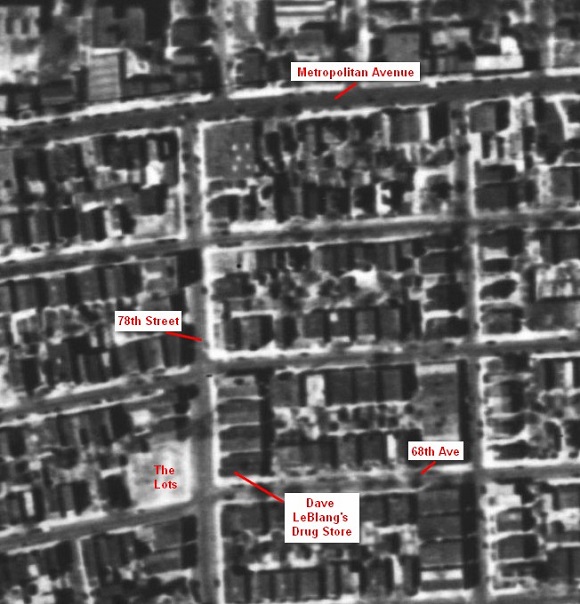As a youngster growing up in Middle Village during the 1930's one of the most important pieces of real estate in the community was situated at the corner of 68th Avenue and 78th Street, opposite Dave Leblang's drug store. It was not a youth center. It was not a medical facility. It was not a mall; indeed, it had no stores. It was not a park, had no benches and little or no vegetation. Yet, it was important and like other well-known real estate: The Empire State Building, The White House, The Taj Mahal, its importance was graced with a name. It was called “The Lots.” It was an empty piece of land probably saved at the time from development by the Depression. I don't know how it came to be called “The Lots” but in retrospect perhaps it simply was a real estate developer's term for a tract of land large enough to be subdivided. In any case, “The Lots” it was. It was not fenced in and at a time when the playground at 68th Road and 79th Street had not yet been built, it was open space and available to the children of the neighborhood for whatever use their imaginations conjured up.
It was a large area, the outer perimeter flat, perhaps 10 feet in width and the center bowl-shaped. Its use encompassed several seasons. Post-Christmas it was the place where discarded Christmas trees were taken and dispatched in a blaze of fire and flying sparks. When it snowed, smaller children used the bowl-shaped area for sledding. In the spring it was the place where small fires were made, and potatoes called mickies (why that name I don't know) were baked or more accurately turned into charcoal.
During the summer months the flat area was used for a marble game called “Banker's Broker,” a forerunner of the Atlantic City games of chance. In this game anyone who had a large quantity of marbles could go into business. He (I don't recall girls ever playing this game) dug a shallow hole and positioned himself behind it. He was known as the Banker. If you wished to play the game you took a handful of your marbles, held them in clasped hands, knelt on the ground about 3 feet from the hole and threw the marbles at the hole. When they stopped rolling the Banker took all those that had not rolled into the hole, neatly gathered them together and placed them off to the side. The marbles in the hole were then removed and counted and if the count was an even number, it meant the Banker lost and was required to pay you an amount of marbles that equaled all those thrown including those that had not rolled into the hole. If the count was an odd number, you lost, and the Banker kept all those thrown.
Another summer game was called “Land.” All you needed was a pocket knife and several players. A square was etched on the surface of the earth and after choosing who went first, the blade was pulled open and the knife thrown towards the square. If it did not land upright and inside the square, the next player threw the knife. Once it did land correctly a line was drawn from the point of penetration to both sides of the square so that a subdivision was made. The knife was thrown again and if it landed upright within the perimeters of a subdivided area another subdivision was made. The point to the game was to make the subdivisions ever smaller so that ultimately, unless you were really good at it, it was not possible to land upright in the smallest area. The person who last threw the knife correctly was declared the winner.
“The Lots” had no garbage but it was a treasure trove of trash, notably large and small cans, bottles, boxes of all sorts and sizes and scraps of lumber. A game called “War” involved picking up all the trash and by placing it on top and alongside each other a fort was constructed. There were two groups, the attackers and the defenders. If the former succeeded in causing the fort to topple over, it was rebuilt, and the roles of the groups reversed. At a time when most of us had few if any toys, little or no money, and no television, it didn't really matter because we did have “The Lots.”




